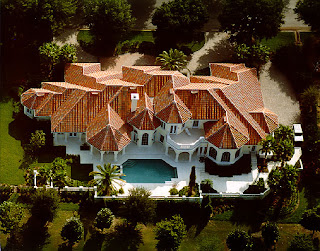All images in this entry are courtesy of Google Image Search.
Hardwick describes the affect ethnicity has on the landscape, particularly in architecture. By recognizing cues in architecture, a person can learn about the history of an area. These cues can be misleading, sometimes they may give insight to the original settlers of an area, but other times these cues are being imitated to create a certain atmosphere to either preserve heritage or to capitalize on tourist interests. Spanish architecture immediately came to mind as fulfilling all of these scenarios across the country.
Spanish architecture is rather distinctive in America, but is similar to Italian architecture and is sometimes referred to as simply "Mediterranean." Although the distinctions between the two are subtle, Spanish architecture has four hallmark features: Red ceramic tile roofs, stucco walls, arches over windows and doors, and low sloping roofs with little or no eaves. These features are evident in the next two images, the first is a picture of a resort in Vera Cruz, Mexico, and the second is a house in Santa Jose, California.
Spanish architecture is prevalent in areas that the Spanish first colonized, evidence of a sort of founder's effect described by Hardwick. Even though Florida and the American South-West have been out of Spanish hands for well over a century, the Spanish housing remains. An interesting case study is Santa Barbara, California. Santa Barbara was originally settled by the Spanish in 1782 as they spread north from Mexico, but was in American hands after the Mexican-American War in the 1840's. Some missions in Santa Barbara date as far back as 1812. In 1925, during a period of time that the town was pushing for a unified Spanish Colonial look, an earthquake struck the city and destroyed much of it. An ordinance passed which declared Spanish architecture would be the "Town's norm." Santa Barbara thus both serves as an example of original Spanish architecture as well as emulating that architecture for a historic and tourist look. The next two photos show the Station 3 fire house, built in 1928 right after the town's destruction, and a view of a neighborhood in modern Santa Barbara. (Station 3's own webpage!)
On the other side of the country, in Florida, Spanish architecture remains just as strong. Several years ago during a family trip to Florida, we took a tour of the Edison house in Ft. Myers, Spanish influence was cited often in the development in the area (As well as the namesake of the even more abundant Spanish Moss). Although thousands of miles away from California, the influences were the same. The following two photos show Spanish styles in Florida, the first credited as "Old Florida" style and the second is a Spanish Revival. (In fact, the entire real estate listing for Rock Creek, CA features Spanish influnenced houses)
Some examples of Spanish Revival architecture have departed from the historic look, but still allude to the heritage of the region. The first photo is a modest house in Los Angeles, CA, and the second is a "McMansion" built in Orlando, FL, for a wealthy European in "Mediterranean Revival" style. Part of the enduring popularity of this style is that the type of construction easily suits the climate of these regions, and wouldn't work well in the harsher winters up north.








1 comment:
That Santa Barbara ordinance is quite fascinating. Does one need to apply for a variance to construct a building in another style?
I love the examples of the modern use of "Spanish" style in suburban houses. Spanish colonial garages . . . hmmm. But look around Buffalo's early 20th-century commercial blocks (Hertel Avenue, for instance) and you'll see examples of Spanish roofing, here in a cold and snowy climate. I wonder what associations the architects were trying to tap into.
Post a Comment